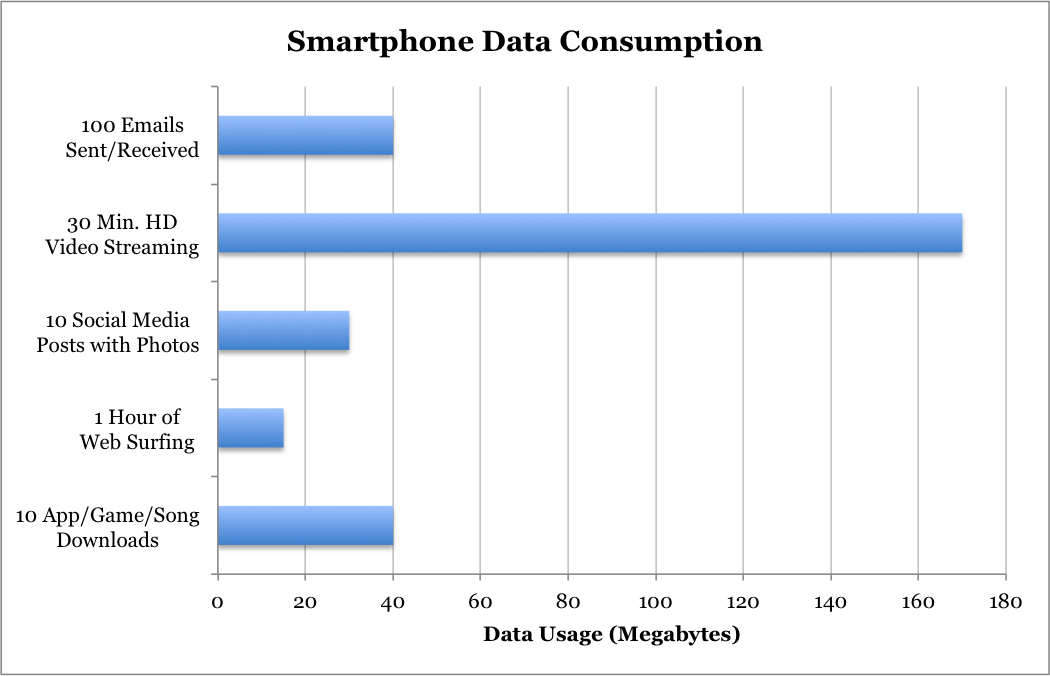
Lost amidst usage-based pricing and ISPs, MBs and GBs, many U.S. customers are unaware of just how much data they consume, and they are in turn purchasing plans with unnecessarily robust allowances, according to a new report.
The findings come by way of a preliminary report released Tuesday by the U.S. Government Accountability Office (GAO). The GAO conducted a survey about usage-based plans (UBPs), in which consumers pay for a capped amount of data. Such plans are offered by various Internet service providers (ISPs) of wireless and wireline (e.g. at-home broadband) services, including AT&T and Comcast, among others. Consumer focus groups and interviews with top ISPs and industry experts revealed that customers may tend to overestimate data usage of common activities, or on the other hand, underestimate usage and unknowingly exceed data caps.
One wireless provider interviewed by the GAO indicated that only a small percentage of users are on 500 megabytes-per-month or smaller data plans, while half of North American wireless customers use fewer than 102 megabytes per month, according to a report by ISP research firm Sandvine.
Additionally, all wireless ISPs interviewed and over half of wireline ISPs surveyed by the GAO offer usage-based plans to various extents. Users who exceed their data caps on such plans can be fined up to $15 per 1GB of additional data or experience throttled-down connection speeds. An AT&T spokeswoman told TIME 97 percent of the company’s DSL customers don’t exceed their monthly data plan, but Sandvine’s report suggests that more customers will do so in the future, as cord-cutting users depending on the Internet as a TV replacement are already consuming roughly 212 GB of data per month, close to many existing data allowances.
But even users with unlimited wireline plans are subject to restrictions, especially if they’re consuming massive amounts of data.
“Last year we discovered a small number of residential customers [of Verizon’s un-capped Internet plan] consuming many terabytes of data each month with their home connections – far exceeding usage levels ever intended for Verizon’s home broadband service,” a Verizon spokesman told TIME in an e-mail. “To put this in context and just for example, these are customers who would have to watch over 4,000 hours, or 166 days-worth of non-stop HD movie viewing over a month’s time to equal their usage levels.”
Verizon—which does not have wireline broadband caps—subsequently requested those customers to move to a business grade service, a move that could be seen as generous, considering some ISPs are slashing unlimited at-home Internet altogether. Verizon came under fire in March when a spokesman inadvertently suggested it would cap its FiOS fiber broadband service, before later posting that it was a miscommunication. In 2011, AT&T implemented monthly limits for its home broadband subscribers. Recently, Comcast announced that it may roll out a wireline data plan with monthly allotments, a suggestion that’s facing harsh criticism as ISPs claim non-unlimited wireline plans may be more fair.
“Explosive Internet use has driven the need for broadband allotments to continue to invest in a sustainable network,” an AT&T spokeswoman told TIME. A Comcast spokesman confirmed to TIME that the company believes the capped approach is more flexible, allowing those who use more broadband can pay more, and those who use less can pay less.
The GAO report indicated that customers had “strong negative reactions” to usage-based pricing on wireline Internet plans. Though the preliminary findings didn’t elaborate on specific reasons for consumers’ harsh reactions, the congresswoman who requested the report—California Democrat Anna Eshoo—warns that capped Internet plans could discourage users from watching Netflix and Amazon Prime, thus encouraging customers to subscribe to more expensive cable TV packages offered by the very same companies potentially switching to capped Internet plans.
“Data caps, particularly when they’re applied discriminatorily, could have the same damaging effect on the free and open Internet as we know it,” Eshoo told the National Journal.
The consumers surveyed by the GAO, however, expressed fewer negative sentiments to wireless mobile plans with usage-based pricing, a trend that’s grown increasingly popular as wireless providers drop unlimited mobile data plans. Major players like AT&T have taken that leap, cutting its unlimited mobile data plan offerings to new customers in 2010 while marketing the change as one that would save customers money. Reports have estimated that 44% of AT&T’s customers are still grandfathered into the unlimited data plans—potentially a lot of overpaying customers, if not all are big data users.
Still, the unlimited wireless data plans that remain on the market are laced with fine print. Sprint and Verizon, two wireless providers that haven’t eliminated their unlimited mobile data plans, announced in May and July respectively they would throttle speeds for some unlimited data plan holders, a sort of data “prioritization,” as Sprint called it. These are among the “loopholes” customers fear their providers will use to overcharge them, according to the GAO report. Still, most customers’ understanding of their basic data use remains clouded, the GAO report suggests.
So just how much data does certain activities use? Online shopping and general surfing is one of the least data-heavy activities, contrary to popular belief, according to the GAO’s report. Meanwhile, video streaming like Netflix is known to be a data hog.
Here are a few wireless data consumption estimates for common smartphone activities to keep in mind:

More Must-Reads from TIME
- Welcome to the Noah Lyles Olympics
- Inside Fiji’s Fiery Battle Against Plastics
- Column: As Biden Vies to Salvage Nomination, Growing Chorus of Democrats Say It’s Too Late
- How to Watch Lost in 2024 Without Setting Yourself Up for Disappointment
- How to Buy Groceries Without Breaking the Bank
- The Rise of the Thirst Trap Villain
- Why So Many Bitcoin Mining Companies Are Pivoting to AI
- The 15 Best Movies to Watch on a Plane
- Sign Up for our Paris Olympics Newsletter
Contact us at letters@time.com